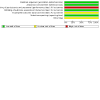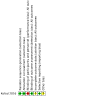Surgery for idiopathic epiretinal membrane
- PMID: 33760235
- PMCID: PMC8095007
- DOI: 10.1002/14651858.CD013297.pub2
Surgery for idiopathic epiretinal membrane
Abstract
Background: Epiretinal membrane is an abnormal sheet of avascular fibrocellular tissue that develops on the inner surface of the retina. Epiretinal membrane can cause impairment of sight as a consequence of progressive distortion of retinal architecture.
Objectives: To determine the effects of surgery compared to no intervention for epiretinal membrane.
Search methods: We searched the Cochrane Central Register of Controlled Trials (CENTRAL), MEDLINE Ovid, Embase Ovid, ISRCTN registry, US National Institutes of Health Ongoing Trials Register ClinicalTrials.gov, and the World Health Organization (WHO) International Clinical Trials Registry Platform (ICTRP). There were no restrictions to language or year of publication. The databases were last searched on 20 May 2020.
Selection criteria: We included randomised controlled trials (RCTs) assessing surgical removal of idiopathic epiretinal membrane compared to placebo, no treatment or sham treatment. Paired or within-person studies were included, as well as those where both eyes of a single participant were treated.
Data collection and analysis: We used standard methods expected by Cochrane, and assessed certainty using the GRADE system. We considered the following five outcome measures: mean change in best corrected visual acuity (BCVA) in the study eye between baseline (before randomisation), 6 months and 12 months later; proportion of people with a gain of 0.3 logMAR or more of visual acuity in the study eye as measured by a logMAR chart at a starting distance of 4 m at 6 months and 12 months after randomisation; proportion of people with a loss of 0.3 logMAR or more of visual acuity in the study eye as measured by a logMAR chart at a starting distance of 4 m at 6 months and 12 months after randomisation; mean quality of life score at 6 months and 12 months following surgery, measured using a validated questionnaire; and any harm identified during follow-up.
Main results: We included one study in the review. This was a RCT including 53 eyes of 53 participants with mild symptomatic epiretinal membrane and BCVA of 65 or more Early Treatment Diabetic Retinopathy Study (ETDRS) letters. Participants were randomly allocated to immediate surgery or to watchful waiting with deferred surgery if indicated by evidence of disease progression. The study was limited by imprecision owing to the small number of participants and was at some risk of bias owing to inconsistencies in the time points for outcome assessment and in the management of lens opacity. At 12 months, the visual acuity in the immediate surgery group was higher by a mean of 2.1 (95% confidence interval (CI) -2.0 to 6.2 ETDRS letters; 53 participants; low-certainty evidence) than the watchful waiting/deferred surgery group. The evidence of the effect of immediate surgery on gains of 0.3 logMAR or more of visual acuity is very uncertain (risk ratio (RR) 0.55, 95% CI 0.06 to 4.93; 53 participants; very low-certainty evidence). At 12 months, no participant in either group sustained a loss of 0.3 logMAR or more of visual acuity (53 participants; low-certainty evidence). The included study did not measure quality of life. At 12 months, no serious adverse event was identified in any participant. One participant developed chronic minimal cystoid macular oedema following immediate surgery (53 participants; low-certainty evidence).
Authors' conclusions: We found no RCT that directly investigated the effect of surgery compared to no intervention. For severe disabling epiretinal membrane, the lack of a RCT comparing surgery to no intervention may reflect evidence from non-randomised studies in favour of surgery; a RCT may be considered unnecessary and ethically unacceptable because a superior effect of surgery is widely accepted. For mild symptomatic epiretinal membrane, however, the value of surgery is uncertain. Low-certainty evidence from this review suggests that watchful waiting or deferred surgery may offer outcomes as favourable as immediate surgery. However, this finding needs to be confirmed in further RCTs with appropriate statistical power, masking of treatment allocation, consistent management of cataract, and measurement of outcomes including patient-reported quality of life over a more extended time frame.
Copyright © 2021 The Cochrane Collaboration. Published by John Wiley & Sons, Ltd.
Conflict of interest statement
AY: no conflicts of interest to declare. MB: no conflicts of interest to declare. CB: no conflicts of interest to declare. JB: no conflicts of interest to declare.
Figures
Update of
- doi: 10.1002/14651858.CD013297
Similar articles
-
Monotherapy laser photocoagulation for diabetic macular oedema.Cochrane Database Syst Rev. 2018 Oct 15;10(10):CD010859. doi: 10.1002/14651858.CD010859.pub2. Cochrane Database Syst Rev. 2018. PMID: 30320466 Free PMC article.
-
Transepithelial versus epithelium-off corneal crosslinking for progressive keratoconus.Cochrane Database Syst Rev. 2021 Mar 23;3(3):CD013512. doi: 10.1002/14651858.CD013512.pub2. Cochrane Database Syst Rev. 2021. PMID: 33765359 Free PMC article.
-
Visual cycle modulators versus placebo or observation for the prevention and treatment of geographic atrophy due to age-related macular degeneration.Cochrane Database Syst Rev. 2020 Dec 17;12(12):CD013154. doi: 10.1002/14651858.CD013154.pub2. Cochrane Database Syst Rev. 2020. PMID: 33331670 Free PMC article.
-
Tamponade in surgery for retinal detachment associated with proliferative vitreoretinopathy.Cochrane Database Syst Rev. 2020 May 13;5(5):CD006126. doi: 10.1002/14651858.CD006126.pub4. Cochrane Database Syst Rev. 2020. PMID: 32408387 Free PMC article.
-
Face-down positioning or posturing after pars plana vitrectomy for macula-involving rhegmatogenous retinal detachments.Cochrane Database Syst Rev. 2024 Mar 15;3(3):CD015514. doi: 10.1002/14651858.CD015514.pub2. Cochrane Database Syst Rev. 2024. PMID: 38488250 Free PMC article. Review.
Cited by
-
Retinal pigment epithelium atrophy after epiretinal membrane and internal limiting membrane peeling: case reports.Rom J Ophthalmol. 2022 Jan-Mar;66(1):79-83. doi: 10.22336/rjo.2022.16. Rom J Ophthalmol. 2022. PMID: 35531456 Free PMC article.
-
Short-term-outcomes of idiopathic epiretinal membranes treated with pars-plana-vitrectomy - examination of visual function and OCT-morphology.Int J Retina Vitreous. 2023 Sep 14;9(1):55. doi: 10.1186/s40942-023-00496-3. Int J Retina Vitreous. 2023. PMID: 37710332 Free PMC article.
-
The effect of diabetes on short-term outcomes following epiretinal membrane surgery.Int Ophthalmol. 2024 Dec 5;44(1):446. doi: 10.1007/s10792-024-03373-6. Int Ophthalmol. 2024. PMID: 39636335 Free PMC article.
-
Untangling the Extracellular Matrix of Idiopathic Epiretinal Membrane: A Path Winding among Structure, Interactomics and Translational Medicine.Cells. 2022 Aug 15;11(16):2531. doi: 10.3390/cells11162531. Cells. 2022. PMID: 36010606 Free PMC article. Review.
-
Association of intravitreal and topical anti-inflammatory therapies on short-term anatomical and functional outcomes following epiretinal membrane surgery.Acta Ophthalmol. 2025 Jun;103(4):416-422. doi: 10.1111/aos.17430. Epub 2024 Dec 20. Acta Ophthalmol. 2025. PMID: 39707151 Free PMC article.
References
References to studies included in this review
Kofod 2016 {published data only}
-
- Kofod M, Christensen UC, la Cour M. Deferral of surgery for epiretinal membranes: Is it safe? Results of a randomised controlled trial. British Journal of Ophthalmology 2016;100(5):688-92. - PubMed
Additional references
Altman 1996
Aung 2013
-
- Aung KZ, Makeyeva G, Adams MK, Chong EW, Busija L, Giles GG, et al. The prevalence and risk factors of epiretinal membranes: the Melbourne Collaborative Cohort Study. Retina 2013;33(5):1026-34. - PubMed
Bainbridge 2020 [pers comm]
-
- Bainbridge A. Deferral of surgery for epiretinal membranes: Is it safe? Results of a randomised controlled trial. Email to: Mads Kofod 11 June 2020. - PubMed
Bu 2014
-
- Bu SC, Kuijer R, Li XR, Hooymans JM, Los LI. Idiopathic epiretinal membrane. Retina 2014;34(12):2317-35. - PubMed
Byon 2015
-
- Byon IS, Pak GY, Kwon HJ, Kim KH, Park SW, Lee JE. Natural history of idiopathic epiretinal membrane in eyes with good vision assessed by spectral-domain optical coherence tomography. Ophthalmologica 2015;234(2):91-100. - PubMed
Covidence [Computer program]
-
- Veritas Health Innovation Covidence. Version accessed 22 April 2020. Melbourne, Australia: Veritas Health Innovation. Available at www.covidence.org.
Dawson 2014
Donati 1998
-
- Donati G, Kapetanios AD, Pournaras CJ. Complications of surgery for epiretinal membranes. Graefe's Archive for Clinical and Experimental Ophthalmology 1998;236(10):739-46. - PubMed
Folk 2016
-
- Folk JC, Adelman RA, Flaxel CJ, Hyman L, Pulido JS, Olsen TW. Idiopathic epiretinal membrane and vitreomacular traction Preferred Practice Pattern ® guidelines. Ophthalmology 2016;123(1):P152-81. - PubMed
Ghazi‐Nouri 2006
Glanville 2006
GRADEpro GDT [Computer program]
-
- GRADEpro GDT. Version McMaster University (developed by Evidence Prime). Hamilton (ON): accessed 28 October 2020. Available at gradepro.org.
Grewing 1996
Higgins 2002
-
- Higgins JP, Thompson SG. Quantifying heterogeneity in a meta-analysis. Statistics in Medicine 2002;21(11):1539-58. - PubMed
Higgins 2017
-
- Higgins JPT, Altman DG, Sterne JAC (editors). Chapter 8: Assessing risk of bias in included studies. In: Higgins JPT, Churchill R, Chandler J, Cumpston MS (editors), Cochrane Handbook for Systematic Reviews of Interventions version 5.2.0 (updated June 2017), Cochrane, 2017. Available from www.training.cochrane.org/handbook.
Kauffmann 2015
-
- Kauffmann Y, Ramel JC, Lefebvre A, Isaico R, De Lazzer A, Bonnabel A, et al. Preoperative prognostic factors and predictive score in patients operated on for combined cataract and idiopathic epiretinal membrane. American Journal of Ophthalmology 2015;160(1):185-92.e5. - PubMed
Kwok 2005
-
- Kwok AK, Lai TY, Yuen KS. Epiretinal membrane surgery with or without internal limiting membrane peeling. Clinical and Experimental Ophthalmology 2005;33(4):379-85. - PubMed
Luu 2019
McDonald 2006
-
- McDonald HR, Johnson RN, Ai E, Jumper JM, Fu AD. Macular epiretinal membranes. In: Wilkinson C, Hinton D, Ryan S, Wilkinson C, editors(s). Retina. 4th edition. Missouri (MO): Elsevier Inc, 2006:2509-25.
Review Manager 2020 [Computer program]
-
- Nordic Cochrane Centre, The Cochrane Collaboration Review Manager 5 (RevMan 5). Version 5.4. Copenhagen: Nordic Cochrane Centre, The Cochrane Collaboration, 2020.
Smiddy 1989
-
- Smiddy WE, Maguire AM, Green WR, Michels RG, la Cruz Z, Enger C, et al. Idiopathic epiretinal membranes. Ultrastructural characteristics and clinicopathologic correlation. Ophthalmology 1989;96(6):811-20. - PubMed
Publication types
MeSH terms
LinkOut - more resources
Full Text Sources
Other Literature Sources




